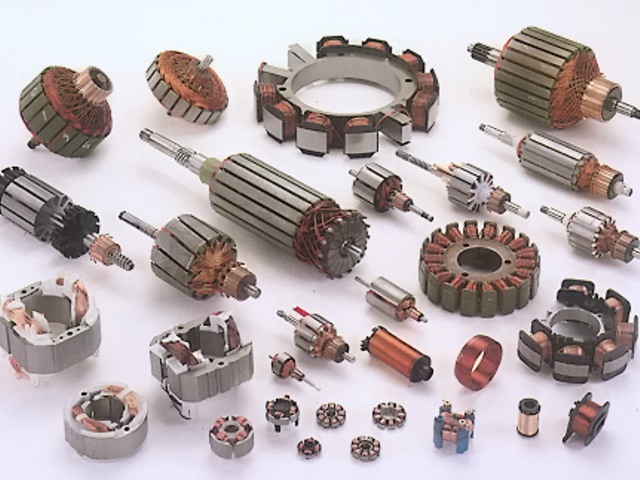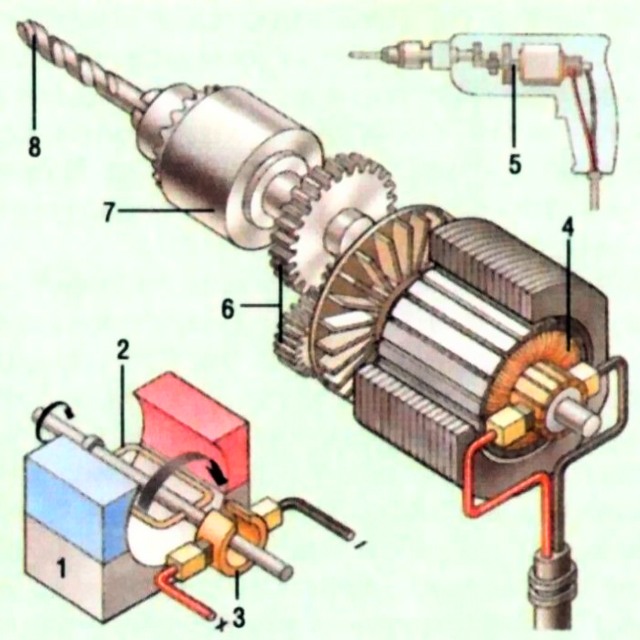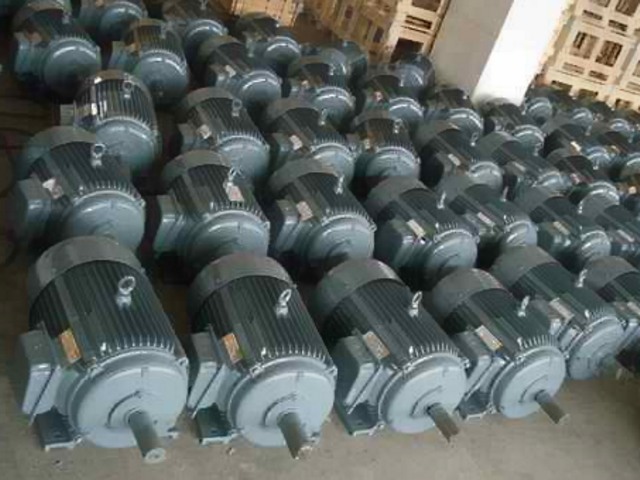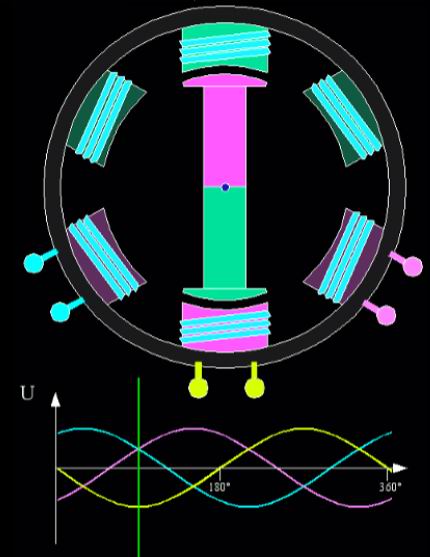Today's topic is a review of various electric motors. Electric motors have found the widest application in science and technology. Human life is difficult to imagine without machines and mechanisms based on electric motors. They are used everywhere - in factories, in automotive engineering, in household appliances, in medical equipment, in one word - everywhere! An electric motor is a kind of converter that converts electrical energy into mechanical energy of rotation of the motor shaft.
The electric motor consists of two main parts - the fixed part (stator) and the rotating part (rotor). The motors are divided into two main groups - DC and AC motors. The main parts of a simple DC motor are the fixed part (stator) of the permanent magnets, in the center a rotor is assembled on the shaft, which consists of steel plates, and a winding is wound around them. The rotor is also called the armature of the electric motor.

Power is supplied through the contacts (brushes) to the winding. As a result of this, the anchor turns into an electromagnet, as a result of a magnetic effect, the rotor tries<ускользнуть> from the magnetic field, and he has nowhere to run away, and the rotor begins to rotate at a higher speed, sometimes the rotor speed in one minute exceeds 10,000! Several windings are usually wound on the rotor to operate efficiently and increase engine power. The diagram below shows the engine in an electric drill.

The motors that operate at a certain frequency of the current, that is, the motors are powered by alternating current, operate mainly at a network frequency of 50-60 hertz. AC motors are divided into two groups - synchronous and asynchronous motors. Mostly they are started manually or have a starting winding. Two-phase or capacitor motors are electric motors that have a finite number of rotor positions. The specified position of the rotor is fixed by applying power to the appropriate winding. The transition to another state is carried out by removing the voltage from one winding and transmitting it to another, so the voltage passes through all the windings, each in turn turns into an electromagnet.

Synchronous is a type of AC motor whose rotor rotates synchronously with the magnetic field of the supply voltage. An asynchronous electric motor is an alternating current motor in which the rotational speed of the rotor differs from the frequency of the rotating magnetic field creating the supply voltage.

The technique mainly uses alternating current motors, it does not use permanent magnets that are designed for stable power, an electromagnet is used for increased power, the power of which increases the power of the permanent magnet many times, although an additional voltage must be applied to supply the electromagnetic winding. In short, all the basic information is sufficient for today, the author is AKA.
Hello dear readers. In this article we will tell you about the electric motor, about its structure and principle of operation. And so, electric motors are devices in which electrical energy is converted into mechanical energy. The principle of their action is based on the phenomenon of electromagnetic induction. However, the ways in which magnetic fields interact, forcing the rotor of an engine to rotate, differ significantly depending on the type of supply voltage - alternating or constant.
The device and principle of operation of a DC motor
The principle of operation of a DC motor is the effect of pushing off like poles of permanent magnets and attracting opposite ones. The priority of its invention belongs to the Russian engineer B. S. Jacobi. The first industrial model of a DC motor was created in 1838. Since then, its design has not undergone major changes.
In low power DC motors, one of the magnets is physically existing. It is attached directly to the machine body. The second is created in the armature winding after connecting a DC source to it. To do this, use a special device - collector-brush unit. The collector itself is a conductive ring mounted on the motor shaft. The ends of the armature winding are connected to it.
Dc motor
In order for a torque to occur, it is necessary to continuously swap the poles of the permanent magnet of the armature. This should occur at the time of crossing the pole of the so-called magnetic neutral. Structurally, this problem is solved by dividing the collector ring into sectors separated by dielectric plates. The ends of the armature windings join them alternately.
To connect the collector to the mains, the so-called brushes are used - graphite rods having high electrical conductivity and low coefficient of sliding friction.
In high power engines, physically existing magnets are not used because of their large weight. To create a constant magnetic field of the stator, several metal rods are used, each of which has its own winding of a conductor connected to the positive or negative power bus. The poles of the same name are connected in series with each other.
The number of pole pairs on the motor housing may be one or four. The number of collector brushes on the collector armature must match.
High power electric motor have a number of constructive tricks. For example, after starting the engine and with a change in the load on it, the node of the collector brushes is shifted by a certain angle against the rotation of the shaft. This is how the effect of the “armature reaction” is compensated, which leads to the shaft braking and reducing the efficiency of the electric machine.
There are also three schemes for connecting a DC motor:
Parallel excitation is when another independent, usually adjustable (rheostat) is turned on parallel to the armature winding.
This method of connection allows you to very smoothly adjust the speed of rotation and to achieve its maximum stability. It is used to power the electric motors of machines and crane equipment.
Sequential - an additional winding is connected in series to the armature power supply circuit. This type of connection is used to dramatically increase the rotational force of the engine at the right time. For example, when starting off trains.
DC motors have the ability to smoothly adjust the rotational speed, so they are used as traction in electric vehicles and lifting equipment.
AC motors - what's the difference?
The device and principle of operation of the AC motor to create torque include the use of a rotating magnetic field. Their inventor is considered the Russian engineer MO. Dolivo-Dobrovolsky, who created in 1890 the first industrial design of the engine and was the founder of the theory and technology of three-phase alternating current.
A rotating magnetic field occurs in the three stator windings of the motor as soon as they are connected to the supply voltage circuit. The rotor of such an electric motor in the traditional version has no windings and is, roughly speaking, a piece of iron, something resembling a squirrel wheel.
The magnetic field of the stator provokes the occurrence of a current in the rotor, and a very large one, because this is a short-circuited structure. This current causes the occurrence of its own armature field, which “engages” with the vortex magnetic sweat of the stator and causes the motor shaft to rotate in the same direction.
The magnetic field of the armature has the same speed as the stator, but lags behind it in phase by about 8–100. That is why AC motors are called asynchronous.
The principle of operation of an AC motor with a traditional, short-circuited rotor has very large starting currents. Probably, many of you noticed this - when starting the engines of an incandescent lamp they change the brightness of the glow. Therefore, in high-power electric machines, a phase rotor is used — three windings connected by a “star” are laid on it.
The armature windings are not connected to the mains, and are connected to the starting resistor by means of a collector-brush unit. The process of switching on such an engine consists of connecting to the supply network and gradually reducing to zero the active resistance in the armature circuit. The electric motor turns on smoothly and without overloads.
Features of the use of asynchronous motors in a single-phase circuit
Despite the fact that the stator's rotating magnetic field is easiest to get from a three-phase voltage, the principle of operation of an asynchronous electric motor allows it to work from a single-phase household network, if some changes are made to their design.
To do this, there should be two windings on the stator, one of which is “starting”. The current in it is shifted in phase by 90 ° due to the inclusion of a reactive load in the circuit. Most often used for this capacitor.
Powered from a household outlet, you can and industrial three-phase motor. To do this, in its terminal box two windings are connected into one, and a capacitor is switched on in this circuit. Based on the principle of operation of asynchronous electric motors powered from a single-phase circuit, it should be noted that they have lower efficiency and are very sensitive to overloads.
This type of electric motor starts easily, but its rotational speed is almost impossible to regulate.
They are sensitive to voltage drops, and when “underloading” they reduce the efficiency, becoming a source of disproportionately large costs of electricity. At the same time, there are methods for using an asynchronous motor as a generator.
Universal collector engines - principle of operation and characteristics
In household power tools of low power, which require low starting currents, high torque, high rotational speed and the possibility of its smooth adjustment, the so-called universal collector motors are used. By design, they are similar to DC motors with sequential excitation.
In such engines, the magnetic field of the stator is generated due to the supply voltage. Only the design of the magnetic cores has been slightly modified - it is not cast, but a dial, which allows reducing the reversal of magnetization and heating by Foucault currents. A series inductance connected to the armature circuit makes it possible to change the direction of the magnetic field of the stator and the armature in the same direction and in the same phase.
The almost complete synchronism of the magnetic fields allows the engine to gain momentum even with significant loads on the shaft, which is required for the operation of drills, rotary hammers, vacuum cleaners, "Bulgarians" or polisher machines.
If an adjustable transformer is included in the supply circuit of such an engine, then its rotational frequency can be smoothly changed. But the direction, when powered from the AC circuit, can never be changed.
Such electric motors are able to develop very high revolutions, are compact and have a greater torque. However, the presence of the collector-brush unit reduces their lifespan - graphite brushes wear out quickly enough at high speeds, especially if the collector has mechanical damage.
The electric motor has the highest efficiency (more than 80%) of all devices created by man. Their invention at the end of the 19th century may well be considered a qualitative civilizational leap, because without them it is impossible to imagine the life of modern society based on high technologies, and something more effective has not yet been invented.
From the name it follows that a feature of this kind of electric motors (ED) is that they operate on alternating current. If at a direct current the electric particles follow only in one direction, and can change their intensity at a certain point in time (potential difference or voltage), then the alternating current has other characteristics, such as frequency, shape, and duration. What influenced the design and principle of operation of AC motors. In the article we will analyze the main aspects of the work of alternating current ED.

AC motors are electrical devices that are a kind of electrical energy converters, the principle of which is based on the Lorentz electromagnetic forces and operating on alternating current. ED and alternators according to the principle of action are classified into synchronous and asynchronous. What would be clear further explanation I want to tell about the following.
The main distinguishing feature of AC electric machines is that electrical energy is converted into mechanical energy or vice versa, using magnetic field interaction, one of them is rotating, dynamic (generated when alternating current moves, and another field is static, constant. For receiving the rotor movement, the moving field must interact with the constant, which creates a mechanical movement of the ED shaft.
The general principle of operation of an asynchronous electric machine is as follows. Three windings are wound on the stator ED, to which three phases are connected. From the course of electrical engineering, we know that the three-phase current is a cyclical change in the magnitude of the current and voltage smoothly flowing through a sinusoid. That is, the maximum power smoothly flows from one point, winding to another, it is clear that, at the same time, on the opposite side of the sinusoid there will be a minimum of power. So, when a three-phase voltage is applied to the stator windings of an asynchronous ED, we have as a result a rotating magnetic field whose frequency is equal to the frequency of the power supply network, in Russia it is 50 Hz.
We know from the course of physics and general electrical engineering that when a conductor moves into an alternating magnetic field, a potential difference is generated at its ends, and if its ends are connected to any circuit, then a current will flow through it, forming around itself its own magnetic field. This principle of operation lies in asynchronous electric machines. Inside it is a short-circuited rotor. In a rotating magnetic field, an emf appears on it and it creates its own magnetic field, which is repelled from the stator field.
The operation of an asynchronous motor is based on the principles of the physical interaction of the magnetic field appearing in the stator with the current that this field generates in the rotor winding.
Synchronous ED has no such lag. There, the inductor's field as if clings to the rotating field of the armature, which leads to the synchronous operation of both magnetic fields. If in asynchronous static field is a consequence of the dynamic, in synchronous in a certain sense, the causes of the appearance of rotating fields and static fields are independent of each other, but their interaction allows the work of alternating current ED.

A synchronous motor is a type of electric motors that only operate on alternating voltage, and the rotational speed of the rotor coincides with the frequency of rotation of the magnetic field. That is why it remains constant regardless of the load, because the rotor of a synchronous motor is a common electromagnet and its number of pole pairs coincides with the number of pole pairs of a rotating magnetic field. Therefore, the interaction of these poles ensures the constancy of the angular velocity with which the rotor turns.
